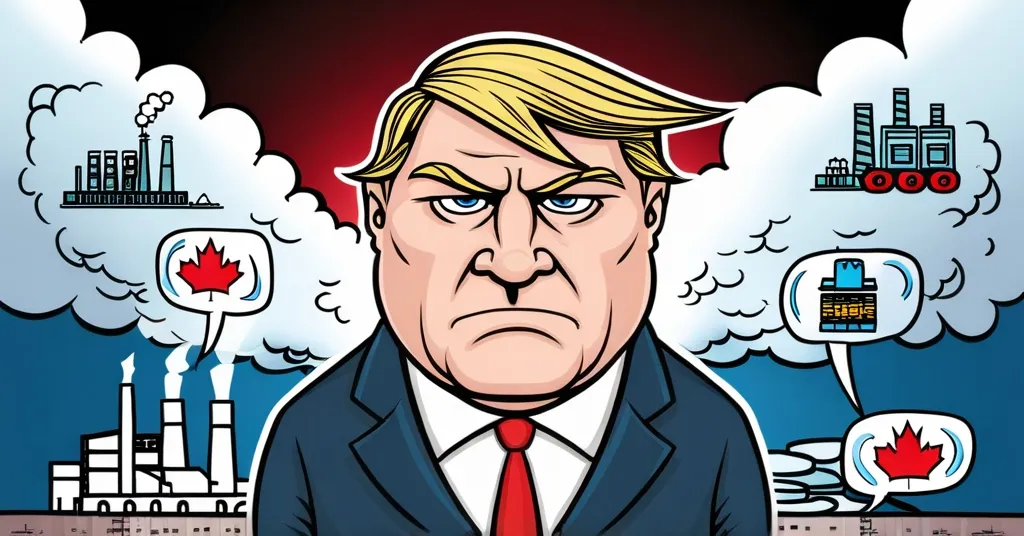Mark Carney’s Firm Stance on U.S. Tariffs Amid Trade Tensions

Canada’s New PM Mark Carney Stands Firm on Tariffs Amidst U.S. Tensions
Mark Carney, the new Prime Minister of Canada, has taken a hard line on tariffs with the United States, refusing to budge until the U.S. shows respect and fairness in trade. This firm stance comes as President Donald Trump threatens a 25% tax on Canadian products, escalating tensions between the two nations.
- Mark Carney vows to maintain tariffs on the U.S.
- Trade tensions escalate with Trump’s 25% tax proposal
- Carney’s economic vision aims to strengthen Canada
- Plans to scrap tax increases and boost infrastructure
- Potential spring election looms
Carney, who won the Liberal Party leadership with a staggering 86% of the vote, is stepping into the role vacated by Justin Trudeau. With extensive experience in central banking, having led both the Bank of Canada and the Bank of England, Carney is well-versed in navigating tough economic situations. His time at these institutions saw him steer through the global financial crisis and Brexit, experiences that have undoubtedly shaped his current approach to the U.S.-Canada trade spat.
His economic agenda is ambitious. Carney aims to fortify Canada’s economy by forging new trade relationships and positioning Canada as an “energy superpower.” Part of his strategy includes scrapping proposed increases to capital gains and carbon taxes. Capital gains tax is a tax on the profit made from selling assets like property or stocks, while carbon taxes are taxes on the carbon content of fossil fuels. Additionally, Carney plans to invest in large-scale infrastructure projects, a move that could invigorate Canada’s economic engine.
Yet, Carney’s leadership comes at a time of political uncertainty. The Liberal Party currently holds less than 50% of the seats in the House of Commons, hinting at a possible spring election. This backdrop adds urgency to Carney’s initiatives and could influence how he navigates the ongoing trade tensions with the U.S.
The political landscape is further complicated by criticism from Conservative leader Pierre Poilievre, who has questioned Carney’s transparency and past business dealings, particularly his time as chair at Brookfield Asset Management Ltd. Poilievre’s critiques highlight the contentious nature of Canadian politics and the challenges Carney faces in maintaining public trust.
As Carney steps into his role, the words of outgoing Prime Minister Justin Trudeau resonate:
“Let there be no mistake, this is a nation-defining moment… Democracy is not a given. Freedom is not a given. Even Canada is not a given.”
These sentiments underscore the gravity of the situation and the importance of Carney’s leadership during these turbulent times.
Carney’s firm stance on tariffs reflects a broader theme of national sovereignty and economic resilience. His refusal to back down from U.S. pressure is a clear signal of his commitment to defending Canada’s interests. As he declared,
“Canada will never be part of America.”
This statement not only emphasizes the current trade disputes but also highlights a deeper narrative of maintaining Canadian identity and independence.
Amidst all this, Carney’s economic vision and leadership style will be closely watched. His plans to strengthen the economy and resist U.S. pressure reflect a blend of pragmatism and ambition, qualities that may prove crucial in navigating the complex web of international trade and domestic politics.
However, the potential impact of Carney’s policies remains a subject of debate. While his refusal to lift tariffs may be seen as a strong stance, it could also lead to prolonged economic uncertainty. The proposed tariffs on Canadian lumber and dairy products, in response to Canada’s high import taxes on U.S. dairy exports (which can reach up to 241%), could affect these industries significantly. Furthermore, Carney’s plans to scrap tax increases and invest in infrastructure may stimulate the economy, but the specifics of these plans need further scrutiny to assess their feasibility and impact.
The reaction from the U.S. to Carney’s stance will be pivotal. While Trump’s threats have caused market jitters, any escalation could lead to a full-blown trade war, which would be detrimental to both nations. On the other hand, a resolution could pave the way for stronger economic ties and mutual respect.
In addition, Carney’s rhetoric during his acceptance speech, emphasizing Canadian sovereignty and resilience, indicates a leadership style that is not afraid to take a stand. This could resonate well with Canadians who value their country’s independence and economic strength.
Key Takeaways and Questions
- What is Mark Carney’s stance on U.S. tariffs?
Carney has pledged to maintain tariffs on the U.S. until they show respect and fairness in trade.
- What are Carney’s main economic plans?
Carney aims to strengthen Canada’s economy, forge new trade relations, position Canada as an “energy superpower,” scrap tax increases, and fund infrastructure projects.
- What criticism has Pierre Poilievre leveled against Carney?
Poilievre has criticized Carney’s transparency and past business dealings, particularly his time at Brookfield Asset Management.
- What is the current political situation in Canada?
The Liberal Party, led by Carney, holds less than 50% of House of Commons seats, and an election might be called soon, potentially in spring.
- How does Justin Trudeau describe the current situation?
Trudeau described it as a “nation-defining moment,” emphasizing that democracy, freedom, and Canada’s existence are not guaranteed.



